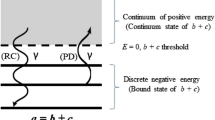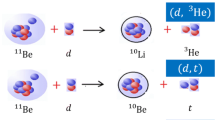Abstract
Nuclear structure and composition in ultra-strong magnetic fields relevant for heavy-ion collisions, supernovae, andmagnetar crusts are analyzed. For field intensities exceeding 0.1 teratesla (TT) nuclear magnetic response is represented as combined reactivity of valent outer-shell nucleons, exhibits linear regime up to a strength of ~10 TT and exceeds significantly nuclear g factor. The Zeeman effect leads to an increase of binding energies for open shell nuclei and a decrease for closed-shell nuclei. Noticeable enhancement and suppression in a yield of corresponding explosive nucleosynthesis products with antimagic and magic numbers corroborate with observational results.
Similar content being viewed by others
References
V. Voronyuk et al. Phys. Rev. C 83, 054911 (2011).
V. N. Kondratyev, Phys. Rev. Lett. 88, 221101 (2002).
V. N. Kondratyev, Eur. Phys. J. A 50, 7 (2014); Eur. Phys. Web Conf. 107, 10006 (2016).
D. S. Svinkin; K. Hurley, R. L. Aptekar, S. V. Golenetskii, and D. D. Frederiks, Mon. Not. R. Astron. Soc. 447, 1028 (2015).
S. Akiyama, C. J. Wheeler, D. L. Meier, and I. Lichtenstadt, Astrophys. J. 584, 954 (2003).
J. C. Wheeler, D. L. Meier, and J. R. Wilson, Astrophys. J. 568, 807 (2002).
M. Obergaulinger, M. A. Aloy, and E. Müller, Astron. Astrophys. 450, 1107 (2005).
S. G. Moiseenko, G. S. Bisnovatyi-Kogan, and N. V. Ardeljan, MNRAS 370, 501 (2006).
A. Burrows, L. Dessart, E. Livne, C. D. Ott, and J. Murphy, Astrophys. J. 664, 416 (2007)
T. Takiwaki, K. Kotake, and K. Sato, Astrophys. J. 691, 1360 (2009).
V. N. Kondratyev and Yu. V. Korovina, JETP Lett. 102, 131 (2015); JNST 1, 550 (2002).
A. S. Davydov, Theory of the Atomic Nucleus (Moscow, Nauka, 1958).
S. V. Vonsovsky, Magnetism (New York, J. Wiley, 1974).
D. Penaa Arteaga, M. Grasso, E. Khan, and P. Ring, Phys. Rev. C 84, 045806 (2011).
S. A. Grebenev, A. A. Lutovinov, S. S. Tsygankov, and C. Winkler, Nature 490, 373 (2012).
T. V. Mishenina, C. Soubiran, O. Bienayme, et al. Astron. Astrophys. 489, 923 (2008).
V. N. Kondratyev, Phys. Rev. C 69, 038801 (2004).
V. N. Kondratyev and M. Di Toro, Phys. Rev. C 53, 2176 (1996).
Author information
Authors and Affiliations
Corresponding author
Additional information
The text was submitted by the author in English.
Rights and permissions
About this article
Cite this article
Kondratyev, V.N. Zeeman Effect at Explosive Nuclide Formation. Phys. Atom. Nuclei 81, 890–893 (2018). https://doi.org/10.1134/S1063778818060224
Received:
Published:
Issue Date:
DOI: https://doi.org/10.1134/S1063778818060224




